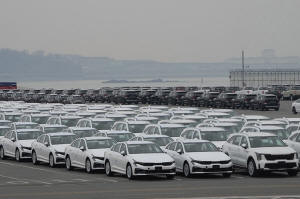Counting the potential toll of Trump's tariffs on major Asian economies
[April 03, 2025] By
ELAINE KURTENBACH
BANGKOK (AP) — The trade war that U.S. President Donald Trump has
escalated in his second term is a challenge for all Asian economies,
large and small, in an era when the most populous region of the world is
expected to drive global economic growth.
Export manufacturing and free trade helped transform China and other
Asian countries into economic powerhouses over the past decades. Trump’s
barrages of tariffs, aimed at compelling companies to keep or set up
their factories in the United States, are rupturing trade agreements
often made at great political cost to trading partners.
The White House says the criteria for raising tariffs will include not
just U.S. trade deficits but also various taxes, exchange rates,
government subsidies and various non-tariff trade barriers. Apart from
the tariffs to be announced on Wednesday's “Liberation Day,” as Trump
calls it, 25% tariffs on imports of autos and auto parts are due to take
effect on Thursday.
Trump has also ordered levies against China, Canada and Mexico; expanded
tariffs on steel and aluminum, and imposed tariffs on countries that
import oil from Venezuela. He plans more import taxes on pharmaceutical
drugs, lumber, copper and computer chips.
Higher costs already have led many manufacturers to shift away from
China to other economies in South and Southeast Asia, Africa and Latin
America. But for now the prevailing uncertainty over what Trump will do
with what he calls “reciprocal” tariffs may lead most to sit tight and
see what comes next.

“There’s no script for how reciprocal tariffs get priced, and
uncertainty is the only constant,” Stephen Innes of SPI Asset Management
said.
Here's a look at how higher U.S. tariffs might affect some major Asian
economies.
China
Despite some decrease in trade since Trump launched a trade war with
China during his first term in office, the U.S. trade deficit has
continued to climb, hitting $295.4 billion last year.
China, the world's No. 2 economy, has leaned heavily on exports to make
up for weak demand at home. The ruling Communist Party has made exports
of autos, especially electric vehicles, and batteries a priority, but
27.5% tariffs on auto exports and 102.5% duties on EVs have in effect
closed the U.S. market for its automakers. China is the second largest
supplier of auto parts to the U.S. behind Mexico.
During Trump's first term, higher tariffs led leader Xi Jinping to
champion a shift to high-tech production. That will likely continue as
U.S. pressure intensifies, causing job losses due to changes in
manufacturing rather than direct damage from the tariffs themselves,
Raymond Yeung of ANZ Research said in a report.
As Trump has rolled out rounds of tariff hikes that have piled on an
extra 20%, China has raised its own import duties, targeting U.S. farm
goods. It also expanded export controls, especially on strategically
important minerals used in high-tech electronics.
U.S. exports of liquefied natural gas (LNG) to China have fallen since
the beginning of the year, and are expected to fall further after
Beijing imposed a 15% tariff on U.S. LNG imports.
Japan
Prime Minister Shigeru Ishiba said Tuesday that his government was
making last ditch efforts to get the United States to exclude his
country from auto tariffs. The U.S. absorbs about one-fifth of Japan's
exports, or about 1.5 million passenger cars a year.

[to top of second column] |

Vehicles for export park at a port in Pyeongtaek, South Korea,
Wednesday, April 2, 2025. (AP Photo/Ahn Young-joon)
 Even though major Japanese
automakers like Toyota Motor Corp., Honda Motor Co. and Nissan Motor
Co. have factories in the U.S. and increasingly, in Mexico, it's an
important industry back home. Nearly 5.6 million people are employed
in auto-related jobs, according to the Japan Automobile
Manufacturing Association.
Japan's exports of electronics, machinery,
chemicals and steel are also potential targets. A central bank
survey released Monday found business sentiment among large
manufacturers worsened in the past quarter, for the first time in a
year. Tokyo's Nikkei 225 share benchmark has fallen more than 10% in
the past three months, while shares in Toyota Motor Corp. have
tumbled 27%.
Taiwan
More than 60% of the self-governed island's economy comes from
exports, and it ran a trade surplus with the U.S. of nearly $74
billion last year. Computer chips are one of Taiwan's biggest
exports to the United States, along with computers and other office
machines and consumer products.
Taiwan Semiconductor Manufacturing Corp. is expanding its U.S.
factories in Arizona, enticed by U.S. incentives and its own
strategic needs. In early March, its CEO C.C. Wei pledged $100
billion in new U.S. investments.
South Korea
South Korea ran a $66 billion trade surplus with the U.S. last year,
and autos, electronics and computer chips were a large share. The
country could boost investments in making autos, steel, and
semiconductors in the U.S. and also consider revising the Korea-U.S.
Free Trade Agreement to promote more balanced trade, Patrick Cronin
of the Hudson Institute said in a recent report.
South Korea is among several big importers of LNG that may try to
buy more of the gas from the US to help balance trade, researchers
at RaboBank said in a recent report.

Vietnam
Like most of its Southeast Asian neighbors, Vietnam has emulated
Japan, China and other major exporting nations in relying on trade
and foreign investment to develop their economies.
It had the third-largest trade surplus with the United States last
year, after Mexico and China, at $123.5 billion. Its biggest exports
are machinery, textiles and footwear.
A 14% increase in exports helped Vietnam's economy expand at a
sizzling 7.1% annual rate last year. The government recently said it
would slash tariffs on LNG, autos, ethanol and some other farm
products, moves meant to placate Trump and reduce its trade surplus.
Vietnam also has agreed to allow a five-year trial launch of Elon
Musk's Starlink satellite internet service.
India
The world's most populous country ran a trade surplus of nearly
$46 billion with the U.S. in 2024, according to the U.S. Trade
Representative's office. The main exports are medicines and
chemicals to make them, pearls, diamonds and other gems.
Exports account for just under a quarter of India's GDP, providing
millions of jobs, and the U.S. is its largest overseas market.
All contents © copyright 2025 Associated Press. All rights reserved |